Shashi Ranjan Kumar
Cooperative Guidance for Aerial Defense in Multiagent Systems
Oct 02, 2025Abstract:This paper addresses a critical aerial defense challenge in contested airspace, involving three autonomous aerial vehicles -- a hostile drone (the pursuer), a high-value drone (the evader), and a protective drone (the defender). We present a cooperative guidance framework for the evader-defender team that guarantees interception of the pursuer before it can capture the evader, even under highly dynamic and uncertain engagement conditions. Unlike traditional heuristic, optimal control, or differential game-based methods, we approach the problem within a time-constrained guidance framework, leveraging true proportional navigation based approach that ensures robust and guaranteed solutions to the aerial defense problem. The proposed strategy is computationally lightweight, scalable to a large number of agent configurations, and does not require knowledge of the pursuer's strategy or control laws. From arbitrary initial geometries, our method guarantees that key engagement errors are driven to zero within a fixed time, leading to a successful mission. Extensive simulations across diverse and adversarial scenarios confirm the effectiveness of the proposed strategy and its relevance for real-time autonomous defense in contested airspace environments.
Nonlinear Cooperative Salvo Guidance with Seeker-Limited Interceptors
Sep 18, 2025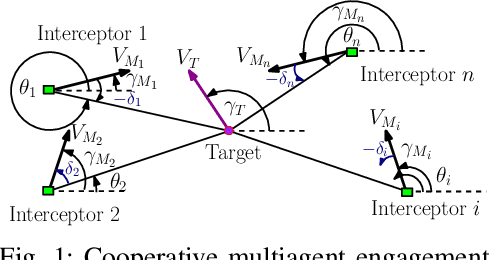
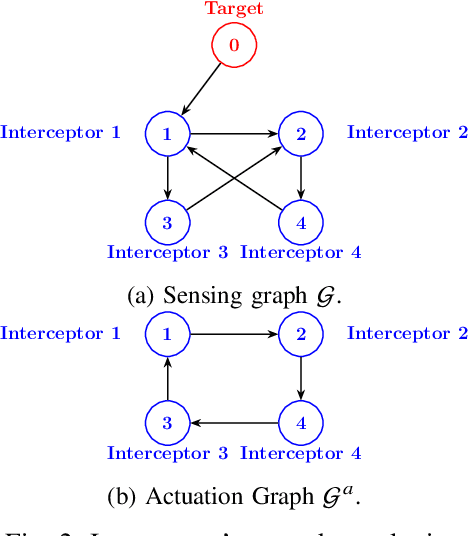
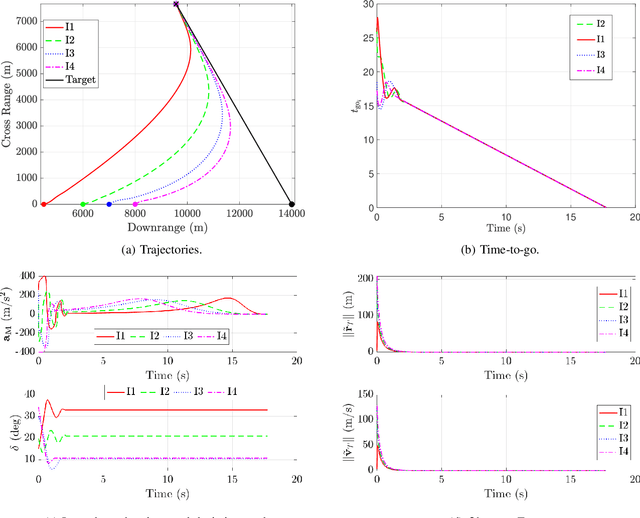
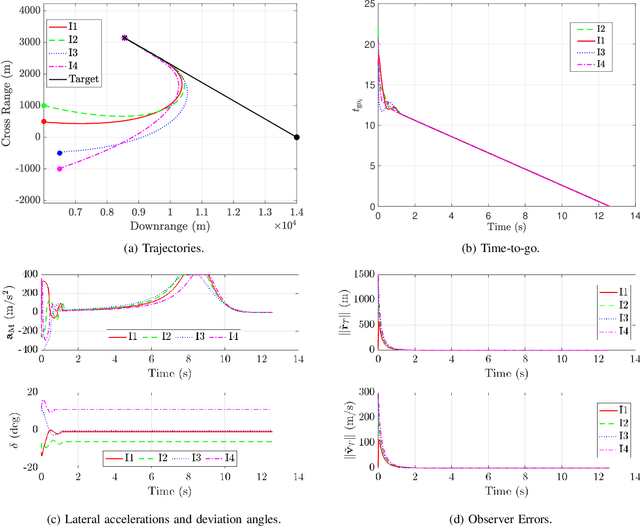
Abstract:This paper presents a cooperative guidance strategy for the simultaneous interception of a constant-velocity, non-maneuvering target, addressing the realistic scenario where only a subset of interceptors are equipped with onboard seekers. To overcome the resulting heterogeneity in target observability, a fixed-time distributed observer is employed, enabling seeker-less interceptors to estimate the target state using information from seeker-equipped agents and local neighbors over a directed communication topology. Departing from conventional strategies that approximate time-to-go via linearization or small-angle assumptions, the proposed approach leverages deviated pursuit guidance where the time-to-go expression is exact for such a target. Moreover, a higher-order sliding mode consensus protocol is utilized to establish time-to-go consensus within a finite time. The effectiveness of the proposed guidance and estimation architecture is demonstrated through simulations.
Cooperative Target Capture in 3D Engagements over Switched Dynamic Graphs
Jul 02, 2025Abstract:This paper presents a leaderless cooperative guidance strategy for simultaneous time-constrained interception of a stationary target when the interceptors exchange information over switched dynamic graphs. We specifically focus on scenarios when the interceptors lack radial acceleration capabilities, relying solely on their lateral acceleration components. This consideration aligns with their inherent kinematic turn constraints. The proposed strategy explicitly addresses the complexities of coupled 3D engagements, thereby mitigating performance degradation that typically arises when the pitch and yaw channels are decoupled into two separate, mutually orthogonal planar engagements. Moreover, our formulation incorporates modeling uncertainties associated with the time-to-go estimation into the derivation of cooperative guidance commands to ensure robustness against inaccuracies in dynamic engagement scenarios. To optimize control efficiency, we analytically derive the lateral acceleration components in the orthogonal pitch and yaw channels by solving an instantaneous optimization problem, subject to an affine constraint. We show that the proposed cooperative guidance commands guarantee consensus in time-to-go values within a predefined time, which can be prescribed as a design parameter, regardless of the interceptors' initial configurations. We provide simulations to attest to the efficacy of the proposed method.
Three-dimensional Nonlinear Path-following Guidance with Bounded Input Constraints
Sep 13, 2024Abstract:In this paper, we consider the tracking of arbitrary curvilinear geometric paths in three-dimensional output spaces of unmanned aerial vehicles (UAVs) without pre-specified timing requirements, commonly referred to as path-following problems, subjected to bounded inputs. Specifically, we propose a novel nonlinear path-following guidance law for a UAV that enables it to follow any smooth curvilinear path in three dimensions while accounting for the bounded control authority in the design. The proposed solution offers a general treatment of the path-following problem by removing the dependency on the path's geometry, which makes it applicable to paths with varying levels of complexity and smooth curvatures. Additionally, the proposed strategy draws inspiration from the pursuit guidance approach, which is known for its simplicity and ease of implementation. Theoretical analysis guarantees that the UAV converges to its desired path within a fixed time and remains on it irrespective of its initial configuration with respect to the path. Finally, the simulations demonstrate the merits and effectiveness of the proposed guidance strategy through a wide range of engagement scenarios, showcasing the UAV's ability to follow diverse curvilinear paths accurately.
Cooperative Salvo Guidance over Leader-Follower Network with Free-Will Arbitrary Time Convergence
Jul 22, 2024



Abstract:A cooperative salvo strategy is proposed in this paper which achieves consensus among the interceptors within a pre-defined arbitrary settling time. Considering non-linear engagement kinematics and a system lag to capture the effect of interceptor autopilot as present in realistic interception scenarios, the guidance schemes use the time-to-go estimates of the interceptors in order to achieve simultaneous interception of a stationary target at a pre-determined impact time. The guidance scheme ensures that consensus among the time-to-go estimates of the interceptors is achieved within a settling time whose upper bound can be pre-specified arbitrarily independent of the initial conditions or design parameters. The efficacy of the proposed guidance strategy is demonstrated using numerical simulations with varied conditions of initial position, velocities and heading angle errors of the interceptors as well as different desired impact times.
Trajectory Tracking for Unmanned Aerial Vehicles in 3D Spaces under Motion Constraints
Jul 15, 2024Abstract:This article presents a three-dimensional nonlinear trajectory tracking control strategy for unmanned aerial vehicles (UAVs) in the presence of spatial constraints. As opposed to many existing control strategies, which do not consider spatial constraints, the proposed strategy considers spatial constraints on each degree of freedom movement of the UAV. Such consideration makes the design appealing for many practical applications, such as pipeline inspection, boundary tracking, etc. The proposed design accounts for the limited information about the inertia matrix, thereby affirming its inherent robustness against unmodeled dynamics and other imperfections. We rigorously show that the UAV will converge to its desired path by maintaining bounded position, orientation, and linear and angular speeds. Finally, we demonstrate the effectiveness of the proposed strategy through various numerical simulations.
Cooperative Nonlinear Guidance Strategies for Guaranteed Pursuit-Evasion
Feb 09, 2024Abstract:This paper addresses the pursuit-evasion problem involving three agents -- a purser, an evader, and a defender. We develop cooperative guidance laws for the evader-defender team that guarantee that the defender intercepts the pursuer before it reaches the vicinity of the evader. Unlike heuristic methods, optimal control, differential game formulation, and recently proposed time-constrained guidance techniques, we propose a geometric solution to safeguard the evader from the pursuer's incoming threat. The proposed strategy is computationally efficient and expected to be scalable as the number of agents increases. Another alluring feature of the proposed strategy is that the evader-defender team does not require the knowledge of the pursuer's strategy and that the pursuer's interception is guaranteed from arbitrary initial engagement geometries. We further show that the necessary error variables for the evader-defender team vanish within a time that can be exactly prescribed prior to the three-body engagement. Finally, we demonstrate the efficacy of the proposed cooperative defense strategy via simulation in diverse engagement scenarios.
Three-agent Time-constrained Cooperative Pursuit-Evasion
Jun 03, 2021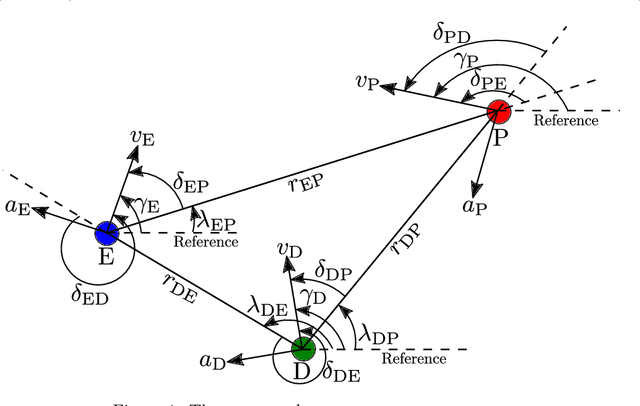

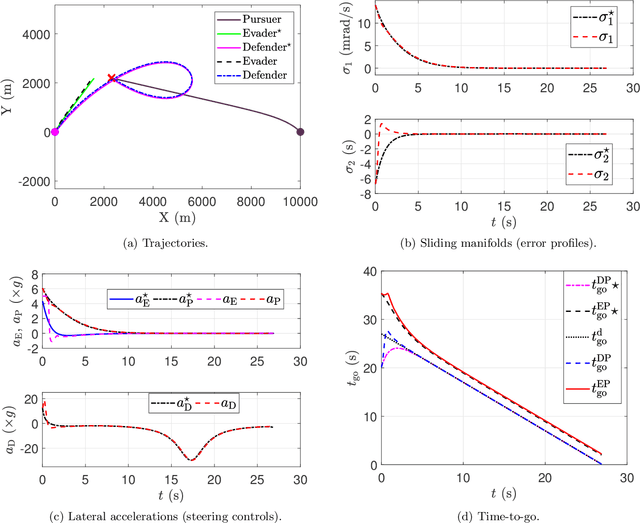
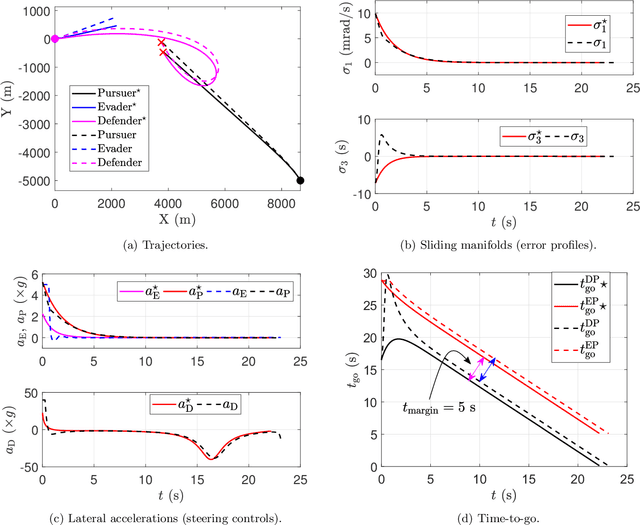
Abstract:This paper considers a pursuit-evasion scenario among three agents -- an evader, a pursuer, and a defender. We design cooperative guidance laws for the evader and the defender team to safeguard the evader from an attacking pursuer. Unlike differential games, optimal control formulations, and other heuristic methods, we propose a novel perspective on designing effective nonlinear feedback control laws for the evader-defender team using a time-constrained guidance approach. The evader lures the pursuer on the collision course by offering itself as bait. At the same time, the defender protects the evader from the pursuer by exercising control over the engagement duration. Depending on the nature of the mission, the defender may choose to take an aggressive or defensive stance. Such consideration widens the applicability of the proposed methods in various three-agent motion planning scenarios such as aircraft defense, asset guarding, search and rescue, surveillance, and secure transportation. We use a fixed-time sliding mode control strategy to design the control laws for the evader-defender team and a nonlinear finite-time disturbance observer to estimate the pursuer's maneuver. Finally, we present simulations to demonstrate favorable performance under various engagement geometries, thus vindicating the efficacy of the proposed designs.
 Add to Chrome
Add to Chrome Add to Firefox
Add to Firefox Add to Edge
Add to Edge